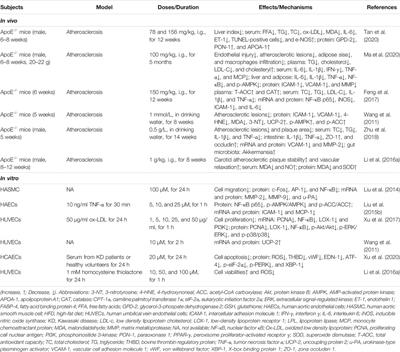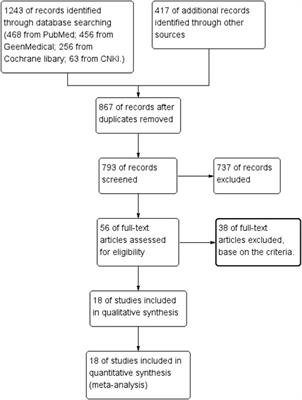
Frontiers | Berberine: A Review of its Pharmacokinetics Properties and Therapeutic Potentials in Diverse Vascular Diseases
Traditional Chinese medicine plays a significant role in the treatment of various diseases and has attracted increasing attention for clinical applications. Vascular diseases affecting vasculature in the heart, cerebrovascular disease, atherosclerosis, and diabetic complications have compromise quality of life for affected individuals and increase the burden on health care services. Berberine, a naturally occurring isoquinoline alkaloid form Rhizoma coptidis, is widely used in China as a folk medicine for its anti-bacterial and anti-inflammatory properties. Promisingly, an increasing number of studies have identified several cellular and molecular targets for berberine, indicating its potential as an alternative therapeutic strategy for vascular diseases, as well as providing novel evidence that supports the therapeutic potential of berberine to combat vascular diseases. The purpose of this review is to comprehensively and systematically describe the evidence for berberine as a therapeutic agent in vascular diseases, including its pharmacological effects, molecular mechanisms, and pharmacokinetics. To this end, we screened articles on berberine treatment in vascular diseases published in the years 2010–2021 using Web of Science, ScienceDirect, PubMed, Google Scholar and China National Knowledge Infrastructure (CNKI) online databases and summarized the findings. According to data published so far, berberine shows remarkable anti-inflammatory, anti-oxidant, anti-apoptotic, and anti-autophagic activity via the regulation of multiple signaling pathways, including AMP-activated protein kinase (AMPK), nuclear factor κB (NF-κB), mitogen-activated protein kinase (MAPK), silent information regulator 1 (SIRT-1), hypoxia-inducible factor 1α (HIF‐1α), vascular endothelial growth factor (VEGF), phosphoinositide 3-kinase (PI3K), protein kinase B (Akt), janus kinase 2 (JAK-2), Ca2+ channels, and endoplasmic reticulum stress. Moreover, we discuss the existing limitations of berberine in the treatment of vascular diseases, and give corresponding measures. In addition, we propose some research perspectives and challenges, and provide a solid evidence base from which further studies can excavate novel effective drugs from Chinese medicine monomers.
Posted by
on 1970-01-01

Frontiers | Efficacy and Safety of Berberine Alone for Several Metabolic Disorders: A Systematic Review and Meta-Analysis of Randomized Clinical Trials
Background: Metabolic activity is the basic life activity of the human body and the fundamental for maintaining body functions. With the improvement of living standards, the incidence of metabolic disorder diseases is also increasing year by year. Most metabolic disorder diseases lack a radical cure, and the existing treatment measures is delayed the course of the disease and reduced complications. At present, most of the clinical treatment strategies and meta-analysis for metabolic disorder diseases are combined medicines, however, there is not enough evidence to disclose the therapeutic effect of the berberine treatment without any combination and the possible factors affecting the efficacy. The purpose of this study is to conduct a systematic review and meta-analysis of the literature to evaluate the therapeutic effect of Berberine in metabolic disorder disease, To further understand the effect of Berberine treatment alone and the possibility of the facets may influence the effect, we have formulated strict inclusion criteria and selected more reliable data for meta-analysis through more refined screening strategies, hoping to provide evidence and guidance for clinical decision-making. Methods and results: Using Meta-analysis of "Cochrane Handbook for Systematic Reviews of Interventions" as guidelines, we searched PubMed, GeenMedical, Cochrane library, CNKI for trails reporting clinical treatment data of Berberine. To increase confidence in results, another 417 trails is included through other sources. Among the 1660 related documents retrieved from the four databases, 18 eligible documents were selected for analysis. Due to the differences in trial design and measurement units, we used the Standardized Mean Differences (SMD) method to eliminate the differences and then summarize the data for analysis. The main factors analyzed are TG, TC, LDL, HDL, HOMA-IR, and FPG. Random-effects model analysis TG (SMD: 0.94; 95%CI: 0.49,1.38; p=0.00), TC (SMD: 1.06; 95%CI: 0.64, 1.48; p=0.00), LDL (SMD: 1.77; 95%CI: 1.11,2.44; p=0.00), HDL (SMD: -1.59; 95%CI: -2.32,-0.85; p=0.00), HOMA-IR (SMD: 1.25; 95%CI: 0.25,2.24; p=0.01), FPG (SMD: 0.65; 95%CI: 0.28,1.03; p=0.00). Conclusions: Berberine can improve obesity and hyperlipidemia by regulating metabolism to reduce TG, TC, LDL and increase HDL; reduce insulin resistance to improve type 2 diabetes, and prevent diabetic encephalopathy.
Posted by
on 1970-01-01